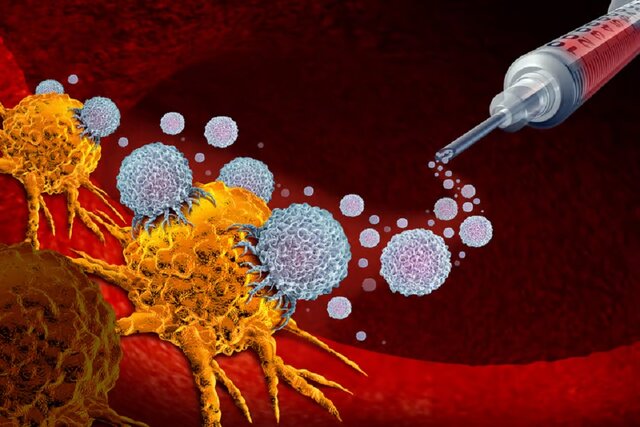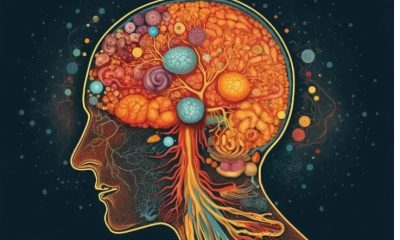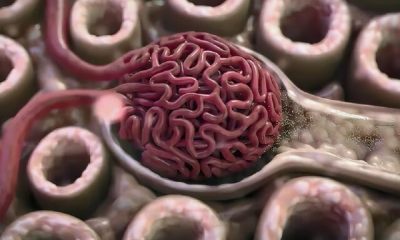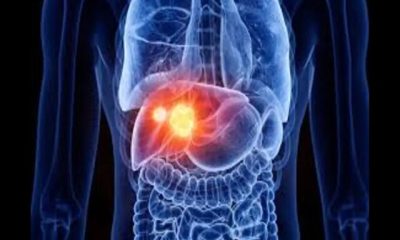Health
Low-cost cancer treatment with a device the size of a microwave
Published
1 year agoon


Low-cost cancer treatment with a device the size of a microwave. A Belgian biotech company is testing a device that produces cancer drugs in hospitals, reducing waiting times and the cost of treatment.
Low-cost cancer treatment with a device the size of a microwave
In this article we’re going to read about Low-cost cancer treatment with a device the size of a microwave. When cancer treatment with a chimeric antigen receptor T cell, or CAR-T, works, it can seem miraculous. About half of leukemia and lymphoma patients, and about a third of myeloma patients, get a complete cure with a single injection of immune T cells that have been genetically modified to find and kill cancer in the blood. CAR-T treatment for acute lymphoblastic leukemia, which is the most common type of childhood cancer, has shown a cure rate of up to 90%. The first two patients treated with CAR-T in 2010 were adult men suffering from end-stage acute lymphoblastic leukemia. They were still in remission a decade after treatment.
Since 2017, the US Food and Drug Administration (FDA) has approved a total of six CAR-T therapies, all for blood cancers. Many studies have been conducted with the aim of using CAR-T therapy on solid tumors, but none are yet at the clinical trial stage. Two of these treatments, known as “Yescarta” and “Tecartus”, have earned 1.5 billion dollars for Kite Pharma in 2022 alone. Until recently, CAR-T therapies were mainly considered a last resort for patients who have tried other drugs, but CAR-T therapy can be used earlier in the treatment process and is likely to have a big impact. Last year, Yescarta was approved as a second-line treatment for large B-cell lymphoma. Despite this, drug makers are currently facing a problem.
A survey conducted in 2022 by Mayo Clinic researchers found that the average time on the waiting list for CAR-T treatment was six months, and only a quarter of patients eventually received it. Another quarter was able to enter a clinical trial for treatments that have yet to be approved. In the past few years, Bristol Myers Squibb, Kite Pharma, and Novartis have all experienced manufacturing problems with their CAR-T therapies. Johnson & Johnson (J&J) and Legend Biotech (Legend Biotech) decided in March to stop launching their CAR-T therapy, Carvycti, in the UK due to production constraints.
Unlike conventional drugs, autologous CAR-T injections are living drugs that are customized for each patient. Blood sampling of patients is usually done in a hospital or special center. Once isolated, the T cells are shipped frozen to a biomanufacturing facility where they are genetically reprogrammed to express a tumor-seeking molecule called a chimeric antigen receptor (CAR) on their surface. The modified cells are placed in an incubator for days or weeks until their numbers increase enough to create a therapeutic dose. After several stages of quality testing, the modified CAR-T cells are frozen and returned to the hospital to be injected into the patient. This process usually takes a minimum of two weeks and a maximum of eight weeks.
Current CAR-T treatments cost between $300,000 and $400,000. Travis Young, vice president of the biology department at the non-profit California Biomedical Research Institute (Calibr), said: “The reason for the high cost of treatment is that the production process must be highly controlled at every point of it.” This requires a trained technician, clean rooms, and infrastructure for transportation and freezing. The most important time is pre-release testing to ensure product sterility and potency. There are many possibilities for problems. The supply chain is still in its infancy, and it’s not just about the infrastructure, it’s about the number of people who need to be trained to do the job.
Companies are tackling these challenges in a variety of ways, aiming to reduce the complexity, time, and cost of delivering CAR-T therapies to more patients. One of the more unlikely competitors is Belgium-based Galapagos NV, which last June announced a bold plan to produce these expensive treatments faster and more cost-effectively. The program proposes developing treatments not in a centralized location, but at the point of care, using a small automated device the size of a home microwave.
Galapagos had no prior experience with CAR-T therapy and had only marketed one product in Europe, the UK, and Japan since its inception in 1999. This product was the drug “Jyseleca” for the treatment of ulcerative colitis and rheumatoid arthritis, whose sales in 2022 were reported to be equal to 95 million dollars. The drug has recently undergone a series of clinical trials, but it has one special advantage: Paul Stoffels, the new CEO of Galapagos and former chief scientific officer of Johnson & Johnson.
When Stoffels left J&J at the end of 2021, he had one of the most enviable track records in the pharmaceutical industry. This Belgian-born doctor and specialist in infectious diseases during his training was in charge of the groups that produced 25 new drugs; including two successful cancer drugs, breakthrough treatments for HIV and tuberculosis, and vaccines for Ebola and Covid-19. Although Carvycti was approved a few months after Stoffels left, it was developed under his watch. During Stoffels’ tenure, J&J’s pharmaceutical sales more than doubled from $22.5 billion in 2009 to $45.6 billion in 2020. Seven of the drugs developed under Stoffels’ supervision have been added to the “World Health Organization’s” (WHO) list of essential drugs, which means that they are considered necessary to maintain health.
Stoffels’ stint in the Galapagos gives him the opportunity to demonstrate his ability in a larger company. Immediately after taking over as CEO last April, Stoffels orchestrated a major pivot, buying two startups working on different aspects of CAR-T therapies and manufacturing them, and four months later hired 200 people working on drug programs. They were working older, fired.
Galapagos sets up manufacturing units at each of its partner hospitals, which includes training people, installing equipment, and validating the manufacturing process, Stoffels explained about the process. This is a new approach but much simpler than centralized manufacturing. In centralized manufacturing, you have to invest several hundred million dollars in a building, hire between 500 and 1,000 people, train them, and produce the drug there, but for us, the heavy lifting of this technology has already been done.
From a biological perspective, using diseased cells that have never been frozen has advantages that affect cell health. Newly generated CAR-T cells, after re-injection into the patient, show robust and consistent growth, which helps minimize a common side effect of CAR-T therapy called cytokine release syndrome, Stoffels continued. This syndrome is an aggressive reaction to immunotherapy that causes fever, nausea, and fatigue. The fact that the treatment can be done in seven days allows people with a very short life expectancy to receive this type of treatment. The first patient treated with CAR-T, who came to the hospital with acute respiratory distress syndrome and severe tumor recurrence, is still in excellent condition. This could never have been done with CAR-T the old way and in one centralized location.
Read More: Scientists discovered the secret of DNA’s X shape
Decentralization, simplification, and automation of the entire process will significantly reduce CAR-T costs, Stoffels added. The time required and the amount of work that needs to be done make CAR-T treatments expensive. If you put four or five systems in a hospital room, you can treat 200 patients a year using only a small staff.
Galapagos will not be immune to shortages of chemical reagents and other raw materials that affect other companies. “All the challenges are compounded by not having trained technicians to do the work,” Travis Young said. Technicians don’t need a lot of training because the systems require a lot less manipulation, but whenever you distribute these systems across hospital centers, you lose some control over them all.
After all, Stoffels has made the impossible possible before, and he’s done it many times, and he doesn’t seem to be giving up. He added: “I have worked all my life trying to get access to medicines.” This work is also such a mission. New science allows us to do new, difficult, and different things, and if you don’t start, you will never reach the goal.


You may like
Health
Discovery of 32 new cancer drugs with the help of artificial intelligence
Published
6 hours agoon
07/05/2024

An artificial intelligence platform developed at the University of California San Diego was able to produce 32 new drugs to target cancer in trials.
Discovery of 32 new cancer drugs with the help of artificial intelligence
UC San Diego scientists have developed a machine learning algorithm for simulating the time-consuming chemistry of the early stages of drug discovery, which could significantly simplify the process and enable the delivery of new treatments.
According to the official website of the University of California San Diego, identifying new drugs for further improvement usually involves thousands of individual experiments, but the new AI platform can provide the same results in a fraction of the time. Scientists used this new platform to produce 32 new cancer drugs.
The technology is part of a new but growing trend in pharmaceutical science to use artificial intelligence to improve drug discovery and development.
“Trey Ideker” (Trey Ideker), a professor of the Department of Medicine at the University of California San Diego School of Medicine and the senior researcher of this project said: “A few years ago, artificial intelligence was a dirty word in the pharmaceutical industry, but now this trend is the opposite because biotechnology startups without addressing AIs find it difficult to raise capital in their business. AI-driven drug discovery has become a very active area in pharma, but unlike methods developed in corporations, we make our technology open-source and available to anyone who wants to use it.
The new platform, called POLYGON, is unique among drug discovery AI platforms because it can identify molecules with multiple targets. Meanwhile, existing drug discovery protocols currently prioritize single-target treatments. Multitargeted drugs are of interest to clinicians and scientists because of their potential to provide similar benefits to combination therapy while having fewer side effects.
Eidker said: Finding and developing a new drug takes years and costs millions of dollars; Especially if it is a multipurpose drug. The few multi-target drugs we have have been discovered largely by chance, but this new technology could take luck out of the equation and usher in a new generation of precision medicine.
The scientists trained POLYGON on a database of more than one million known bioactive molecules, containing detailed information about chemical properties and known interactions with protein targets. By learning from the patterns in the database, the POLYGON algorithm can generate the original chemical formulas for new drugs that are likely to have properties such as the ability to inhibit specific proteins.
Just as artificial intelligence is now very good at producing original drawings and images, such as creating images of human faces based on arbitrary characteristics such as age or gender, POLYGON can also produce original molecular compounds based on desired chemical properties. In this case, instead of telling the AI how old we want our face to be, we tell it that we want our future drug to interact with disease proteins.
To test POLYGON, scientists used it to generate hundreds of drugs that target different pairs of cancer-related proteins. Of these, they produced 32 molecules that had the strongest predicted interactions with MEK1 and mTOR proteins. These two are cell signaling proteins that are promising targets for combination cancer therapy. Inhibiting both proteins together is enough to kill cancer cells; Even if the containment of one of them is not done alone.
The researchers found that the drugs they developed had significant activity against MEK1 and mTOR, but showed few off-target reactions with other proteins. This suggests that one or more of the drugs identified by POLYGON could target both proteins as cancer therapies, providing a list of options for fine-tuning by human chemists.
Related article: Transforming invasive cancer cells into healthy cells!
“After you get the drugs, you still have to do other chemical work to make those drug options into a single, effective treatment,” Edker said. We cannot and should not try to remove human expertise from the drug discovery process, but rather shorten some of the steps in the process.
Despite this caution, scientists are optimistic about AI’s potential for drug discovery. Eidker added: It will be very exciting to see how this concept will be implemented in the next decade, both in the university and in the private sector. The capabilities of artificial intelligence are virtually endless.
This research was published in “Nature Communications” magazine.


A vaccine made with messenger RNA (mRNA) technology against glioblastoma, a deadly form of brain cancer, has shown promise in a new clinical trial.
Brain cancer vaccine success in human trials
Glioblastoma is one of the deadliest cancers for which few treatment options are available.
Now, a small human clinical trial has shown the efficacy of an mRNA vaccine that rapidly primes the immune system to fight tumors, with promising results, according to NA.
Glioblastoma is the most common form of brain cancer and unfortunately, it is also known as the most aggressive brain cancer.
Glioblastoma is the most common primary malignant tumor of the central nervous system that occurs in the spinal cord or brain. The origin of this tumor is from astrocyte cells (a type of glial cell).
Treatment for glioblastoma includes a combination of surgical removal, radiation therapy, and chemotherapy, but the disease almost always recurs, and patients with it usually survive only about a year after diagnosis, with only about 5 percent of patients surviving more than five years.
A new study from the University of Florida may soon provide these patients with a better option, the mRNA cancer vaccine.
The technology, best known for COVID-19 vaccines, has been shown to quickly prime the immune system to more effectively attack glioblastoma in mice, dogs, and now humans.
As you may remember from the critical days of 2020 and 2021 due to the outbreak of the COVID-19 pandemic, mRNA molecules are essentially natural blueprints that tell cells which proteins to produce and by engineering them to produce harmless versions of the proteins. Associated with pathogens, the immune system can be trained to fight off a true invader when it appears.
Following the real-world success of these treatments during the pandemic, the possibility of adapting mRNA therapies for cancer has emerged with interesting early results.
University of Florida researchers say this new version has two key improvements. First, the vaccine is personalized using samples taken from the patient’s tumor cells. Second, the delivery mechanism is more complex, which ultimately leads to a stronger immune response.
Related article: Testing a vaccine that reduces liver tumors
“Instead of injecting single particles, we inject clusters of particles that are wrapped around each other like the layers of an onion, like a bag full of onions,” said Elias Sayor, senior author of the study. In less than 48 hours, we can see that these tumors change from the so-called cold state, which indicates very few immune cells and a muted immune response, to a warm and highly active immune response state.
He added: This was very surprising. Given how quickly this happened, what it told us is that we were able to activate the early part of the immune system quickly against these cancers, and that’s very important for unlocking the downstream effects of the immune response.
This small clinical trial approved by the US Food and Drug Administration (FDA) was designed to test safety and feasibility and included only four patients with glioblastoma. RNA was extracted from each patient’s tumor after surgical resection, then the mRNA was amplified and wrapped into particle clusters. It was then injected into patients, where it stimulated an immune response.
The team says it’s too early to fully assess the vaccine’s clinical effects, but patients spent more time disease-free and survived longer than expected.
A large-scale trial will be conducted soon, including up to 24 patients, to determine the optimal and safe dose of this vaccine. Next, the next phase of the experiment includes 25 children.
This research was published in the journal Cell.


Many mental disorders have physical roots
Jessica Huston’s tics started when she was just 12 years old. Over time, his condition worsened until he had a seizure and was rushed to the hospital. Doctors at a local hospital in Durham, England, dismissed his condition and said he was suffering from anxiety and probably spent a lot of time watching TikTok videos.
Jessica actually suffers from an autoimmune disease caused by a streptococcal bacterial infection. His illness was a form of pediatric autoimmune neuropsychiatric disorder associated with streptococcal infections (PANDAS). When the infection was identified and treated, her symptoms eventually began to improve.
Ms. Huston is not the only person with a brain dysfunction that is mistaken for a mental disorder. A lot of evidence shows that a series of infections can cause conditions such as obsessive-compulsive disorder, tic, anxiety, and even psychosis. Inflammatory and metabolic disorders can also have significant effects on mental health, although they are rarely considered by psychiatrists.
Rethinking the cause of mental disorders could have profound implications for the millions of people with mental illnesses who are currently undertreated. For example, more than 90% of patients with bipolar disorder develop recurrent illnesses during their lifetime. More than 46% of children with obsessive-compulsive disorder do not recover. About 50 to 60 percent of patients with depression eventually recover after trying different drugs. A deeper understanding of the biological components of mental health can lead to more accurate diagnoses and more targeted treatments.
Infections can cause obsessive disorder, tic, anxiety, and even psychosis
For a long time, the field of psychiatry has focused on describing and classifying symptoms rather than on underlying causes. The Diagnostic and Statistical Manual of Mental Disorders (DSM) was published in 1952 and contains descriptions, symptoms, and diagnostic criteria. Although this guide has helped unify diagnoses, it groups patients without considering the underlying mechanisms of mental disorders.
There is a lot of overlap between the symptoms of depression and anxiety, and some question whether they are really separate illnesses. At the same time, depression and anxiety exist in different forms. For example, panic disorder with and without agoraphobia are different diagnoses, but we may not find significant differences between them. This can lead to a high diversity of patients participating in drug trials, and these trials do not achieve results due to the few commonalities and large differences among the participants.
Previous attempts to find causal mechanisms for mental illness have been challenging. In 2013, the National Institute of Mental Health tried to distance itself from research based on classifications based on DSM symptoms. Huge budgets have been spent on research into brain disease processes with the hope of linking genes directly to behaviors. But this idea ultimately failed and most of the genes discovered had small effects.

Although genes may play a role in mental disorders, they are not the only answer. Many disorders such as schizophrenia, attention deficit hyperactivity disorder, anxiety, and autism can be caused by genetic disorder 22q11.2, in which part of chromosome 22 is deleted, says Ludger Tebartz van Elst, professor of psychiatry and psychotherapy at Freiburg University Hospital in Germany.
In 2007, studies conducted at the University of Pennsylvania showed that 100 patients with psychiatric symptoms or cognitive deficits actually had some kind of autoimmune disease. Their bodies were making antibodies against a key receptor in nerve cells called the NMDA receptor. This leads to swelling of the brain and can cause a wide range of symptoms including paranoia, hallucinations, and aggression. The disease described was called anti-NMDA receptor encephalitis, and in many cases, it was treatable by removing the antibodies or using immunotherapy drugs or steroids. Studies conducted on patients who had the first episode of psychosis have shown that between 5 and 10 percent of them also had antibodies that attack the brain.
It seems that in rare cases obsessive-compulsive disorder can also be caused by the immune system. This condition is seen in childhood PANDAS, which Ms. Houston was diagnosed within 2021. This disorder is sometimes seen in adults as well. A 64-year-old man spent a lot of time mowing his lawn, but the next day he felt remorse and guilt. The researchers found that these symptoms are caused by antibodies attacking the neurons in his brain.
Recently, Belinda Lennox, director of the Department of psychiatry at the University of Oxford, conducted experiments on thousands of patients with psychosis. He has found antibodies in blood samples of about 6% of patients, which mainly target NMDA receptors. He says it’s not clear how a set of antibodies can cause clinical symptoms ranging from seizures to psychosis to encephalitis. It’s also not clear why these antibodies are made or if they can cross the blood-brain barrier (the membrane that controls access to the brain). He hypothesizes that antibodies cross the blood-brain barrier and affect memory by binding to the hippocampus, leading to delusions and hallucinations.
Studies have shown that some patients with psychological symptoms or cognitive defects have some kind of autoimmune disease
Dr. Lennox says a medical rethink is needed to understand the damage the immune system can do to the brain. He is conducting experiments in this field.
Studies of patients with immune-mediated psychosis show that a wider range of strategies, including the removal of antibodies and the use of immunotherapy drugs or steroids, can be effective treatments.
People with myalgic encephalomyelitis/chronic fatigue syndrome (an infectious disease associated with a range of cognitive problems such as difficulty concentrating and paying attention) were once neglected or diagnosed as retarded. New research shows that myalgic encephalomyelitis is related to both immune disorders and metabolic disorders.
Metabolic disorders can also affect mental health. The brain is an extremely energy-demanding organ, and metabolic changes related to energy pathways are involved in various disorders, including schizophrenia, bipolar disorder, psychosis, eating disorders, and major depressive disorder.

At Stanford University, there is a metabolic psychiatry clinic where patients are treated with diet and lifestyle changes along with medication. An active area of research at this clinic is the potential benefits of a ketogenic diet, where carbohydrate intake is limited.
A ketogenic diet forces the body to burn fat for energy, creating chemicals known as ketones, which can be used as a fuel source in the brain when glucose is limited.
Metabolic disorders can affect mental health
Thirteen trials are underway around the world to examine the effects of metabolic therapies on serious mental illness, says Kirk Nylen, head of neuroscience at the US charity Bazoski Group, which funds brain research.
The preliminary results have shown that a large group of patients respond to these treatments in a meaningful way. Medicines, talk therapy, brain magnetic stimulation, and maybe electroshock therapy have not been effective for this group of patients.
It is not just the understanding of the immune and metabolic systems that is improving. Massive amounts of data are now being analyzed at unprecedented speed to reveal connections that were previously hidden from view. This could ultimately lead to more personalized and better treatments.
In early October 2023, the UK Biobank published data showing that people with depressive episodes had higher levels of inflammatory proteins such as cytokines in their blood. According to another study, about a quarter of depressed patients showed evidence of mild inflammation. Knowing this can be helpful because other research shows that patients with inflammation respond poorly to antidepressants.
There are new advances in understanding the underlying causes of mental disorders. A group of researchers are investigating different ways to improve the diagnosis of ADHD; Like classifying patients into different subgroups, some of which were previously unknown. Different groups of researchers announced in three different statements in February 2024 the discovery of biomarkers that can predict the risk of dementia, autism, and psychosis.
The search for better diagnostic tools is also likely to be accelerated by the use of artificial intelligence. A company called Cognoa is using artificial intelligence to diagnose autism in children by analyzing videos of their movement behaviors in doctors’ waiting rooms.
The Quantitative Biosciences Institute (QBI) in California has used artificial intelligence to create an entirely new map of the interactions between proteins and molecular networks involved in autism. This will greatly facilitate finding diagnostic and therapeutic tools.
The developments mentioned are promising. But many problems can be solved by reducing the gap that exists today between neurology and psychiatry. Neurology studies and treats physical, structural, and functional disorders of the brain, while psychiatry deals with mental, emotional, and behavioral disorders. Dr. Lennox envisions a future in which antibody testing is performed when a person who develops a sudden mental breakdown after a viral infection fails to recover with standard treatments.
According to Dr. Tebartz van Elst, the gap between neurology and psychiatry is greater in Anglo-Saxon countries (including the United States, Great Britain, Canada, and New Zealand). In Germany, psychiatry and neurology are closer together, so neurologists are trained in psychiatry and psychiatrists are trained in neurology for one year. This makes research work easier.
For most patients who are first diagnosed with psychosis or other severe psychiatric syndromes, Dr. Tebartz van Elst prescribes brain MRIs, electroencephalograms, laboratory tests for inflammation, and lumbar punctures in order to better treat them by finding clues to the cause of the illness. Submitted.


Discovery of 32 new cancer drugs with the help of artificial intelligence


NASA is going to space exploration with a 36-pixel camera


Brain cancer vaccine success in human trials


MacBook Air M3 review; Lovely, powerful and economical


How to prevent the earth from being baked by the scorching sun?


The secret of the cleanest air on earth has been discovered


How extinct animals could be brought back from death?


Xiaomi Pad 6S Pro review


Testing a vaccine that reduces liver tumors


How can solar storms destroy satellites so easily?
Popular
-



 Technology9 months ago
Technology9 months agoWho has checked our Whatsapp profile viewed my Whatsapp August 2023
-



 Technology10 months ago
Technology10 months agoHow to use ChatGPT on Android and iOS
-



 Technology9 months ago
Technology9 months agoSecond WhatsApp , how to install and download dual WhatsApp August 2023
-



 Technology11 months ago
Technology11 months agoThe best Android tablets 2023, buying guide
-



 AI1 year ago
AI1 year agoUber replaces human drivers with robots
-



 Humans1 year ago
Humans1 year agoCell Rover analyzes the inside of cells without destroying them
-



 Technology10 months ago
Technology10 months agoThe best photography cameras 2023, buying guide and price
-



 Technology11 months ago
Technology11 months agoHow to prevent automatic download of applications on Samsung phones









